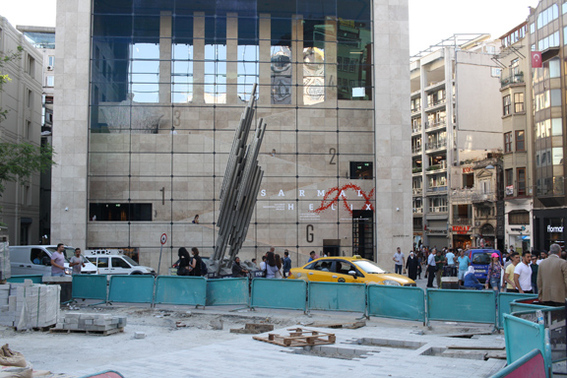
R
E
V N
E
X
T
The Yapı Kredi Culture and Art (Yapı Kredi Kültür Sanat) center reopened to the public on September 13, after being closed since early 2011 for building renovations. The first display of the Yapı Kredi bank’s collection, entitled “Sarmal (Helix),” has been curated by art historian Necmi Sönmez, who intertwined important 20th and 21st-century artworks from Turkey, stretching back to the late Ottoman period, along with displays of coins reaching back thousands of years.
Residents of Istanbul were struck by the dramatic makeover to drab modern building at the turning point of the city’s most famous street, which was kept under wraps until just days ago. The side of the building facing Galatasaray Square, a central meeting point along Istiklal Avenue, has been transformed into a multi-storey wall of glass, and the gray exterior with small square windows was clad entirely in stone. From the outside, passersby can now see the stairways to the galleries, above which rises the dramatic 1980 sculpture by İlhan Koman of a female figure made from white-painted vertical bands, Akdeniz (“Mediterranean,” or literally “The White Sea” in Turkish), which faces out onto the street. Koman’s sculpture had previously been located outside an office building in the Levent business district and had been badly damaged in 2014 during protests against the nearby Israeli consulate. The glass exterior wall now also handsomely frames the under-appreciated public sculpture by Şadi Çalık in the Galatasaray Square that commemorates the 50th anniversary of the Turkish Republic.
The unveiling of the building, and its eye-catching appearance, as well as its vast new bookstore—Yapı Kredi is a major publisher of Turkish literature, history, culture and art books—seemed to take people by surprise. In recent years, İstiklal Avenue, and the Beyoğlu district at large, has been disfigured by horrific municipal neglect and is now currently undergoing major street renovations; for one, a drainage system is being installed in order to solve the chronic flooding which plagues the streets, despite being on the top of a hill. Making matters worse have been the real estate developers who transformed the area’s iconic 19th-century mansions and pasaj (“arcades”) into air-conditioned shopping malls with illegally constructed extra floors, or into outlets of mega-chains, displacing the local businesses and restaurants that had made the street a treasured destination in the first place.
In a city and country that has anguished, and protested, over the transformations of buildings, the Yapı Kredi Cultural Center building received immediate and surprised reviews, in conversation and on social media. On a quick glance through the galleries, the opening exhibition, curated by art historian Necmi Sönmez, titled “Sarmal” (“Helix”), featured several seminal modern artworks from Yapı Kredi’s collection, including large canvases by Aliye Berger and Nurullah Berk from a painting competition held by the bank in 1954, and a self-portrait by female painter Mihri Müşfik, along with displays of coins reaching back thousands of years.
Historically, the center has served as the venue for many important contemporary art exhibitions in Istanbul. Before closing, a series of shows titled “Adventure İstiklal,” organized by German gallerist and curator René Block, were hosted in the center’s Taskent Gallery. The shows highlighted contemporary Turkish artists including Sarkis, Esra Ersen, Hale Tenger, Gülsün Karamustafa, Füsun Onur and Halil Altındere, and coincided with a set of monographs on the artists by Yapı Kredi Publishing.
“Sarmal” will remain on view until the end of 2017.
HG Masters is editor at large of ArtAsiaPacific.
To read more articles by ArtAsiaPacific, visit our Digital Library.



